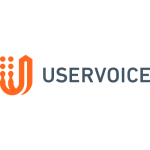About MongoDB Atlas
MongoDB Atlas is a cloud database service for applications that works with Amazon AWS, Microsoft Azure, and Google Cloud Platform. The database service seeks to comply with the most stringent data security and privacy standards while offering a reliable suite of drivers, tools, and integrations. By automating numerous database management tasks, MongoDB Atlas helps developers build apps faster with less human error.
About UserVoice
UserVoice offers product developers a single interface that collects and analyzes customer feedback from a variety of sources. This gives product makers clear, actionable insights into how to improve their offerings. UserVoice eliminates the need to send out surveys, log emails, and search through message boards when trying to understand customer experiences. When a customer reports a complaint or submits an enhancement request through UserVoice, the customer stays in the loop with updates on how their submission is being considered and resolved. This boosts customer engagement and willingness to provide feedback and ideas for product improvement in the future.
Popular Use Cases
Bring all your UserVoice data to Amazon Redshift
Load your UserVoice data to Google BigQuery
ETL all your UserVoice data to Snowflake
Move your UserVoice data to MySQL
MongoDB Atlas's End Points
MongoDB Atlas Automated Features
The automated security features included in MongoDB Atlas let you monitor who has access to your data while securing your information against unwanted intrusions. Also, due to the platform's automation of mundane operational tasks — like provisioning and configuration, patching and upgrades, monitoring and alerts, advanced security automation, and disaster recovery — you don't have to be a data science expert to set up and run your databases.
MongoDB Advanced Security Automation
MongoDB Atlas provides a variety of database security layers including advanced access control, IP whitelists, in-flight data encryption through TLS/SSL, optional encryption of your file system, and network isolation through Amazon VPCs and VPC Peering.
MongoDB Atlas Built-In Replication
MongoDB Atlas offers multiple servers to provide 'always-on' availability. Even if your primary master goes down, multiple backups ensure that your system is always up and running.
MongoDB Atlas Backups and Time-Machine Recovery
The advanced backup and recovery features for MongoDB Atlas guard against data corruption. Whether the threat is from hackers or a team member's innocent mistake, you can rest easy knowing that, after a catastrophic, event you'll have a backup copy to recover your system from a specific time in the past.
MongoDB Atlas Detailed Statistics and Monitoring
MongoDB Atlas provides detailed information and statistics about your database systems. By organizing this information in numerous ways, the platform helps you understand when important changes or upgrades to your system may be necessary. Moreover, if it's time to make changes, you can provision new server instances in a flash.
MongoDB Atlas Automated Patches and Upgrades
Whether it's a new technology upgrade to improve database efficiency or a security patch to protect against a new security threat, MongoDB Atlas automatically upgrades or lets you upgrade with a single click, so you can take advantage of features as soon as they're available. Upgrades happen in a matter of minutes without any downtime required.
MongoDB Atlas Customizable Database Tools
MongoDB Atlas includes a suite of tools that allow you to select your regions, billing options, and more — allowing you to customize server instances to your desired specifications.
MongoDB Atlas Scalability
MongoDB Atlas scales up and down — or scales out horizontally through automatic sharding — according to the needs of your company with zero application downtime. This allows you to grow beyond the limitations of one server without making your application too complex. Moreover, the platform's automatic balancing keeps information equally distributed across multiple replica sets as your data volumes grow, or as your cluster increases or decreases.
UserVoice's End Points
UserVoice Turnkey Install-less Feedback
UserVoice includes a custom-brandable, stand-alone web portal, where your customers can go to provide direct feedback. Users can type in their feedback while receiving auto-suggestions to match their feedback with existing user suggestions. This reduces the chance of feedback duplication and facilitates the surfacing of top ideas. If an issue or enhancement suggestion doesn't exist, users can add a new one. Then, other customers can upvote the suggestion to help you understand the requests to address with the highest priority.
UserVoice In-App Feedback Channel Integration
UserVoice offers cut-and-paste Javascript code that you can insert into your applications and webpages. This embeds a 'Give Feedback' button so users can provide immediate suggestions while they're using your product.
UserVoice Contributor Sidebar
The Contributor Sidebar is a UserVoice web browser extension that customer-facing teams can use to relay the feedback they capture while interacting with customers. Instead of needing to send an email or drop a post-it note off on a manager's desk, sales associates and customer-facing reps can submit feedback and ideas about enhancement requests and areas for product improvements into the UserVoice system. The Contributor Sidebar browser extension also allows sales teams to connect the feedback they send to an actual customer, who will receive email updates on the status of his or her enhancement request. The sidebar also keeps customer-facing teams in the loop on new developments and progress so they can communicate news to the customers they interact with.
UserVoice Metrics on Product Improvement Opportunities
UserVoice analyzes and groups incoming feedback into easy-to-understand product improvement suggestions, so development teams can understand the number of customers requesting the same improvements. Through visual metrics, graphs, and charts, UserVoice presents valuable information, such as the revenue represented by the customers making specific enhancement requests and how many users want those improvements. This empowers development teams to prioritize the most valuable improvement opportunities.








